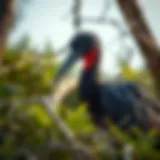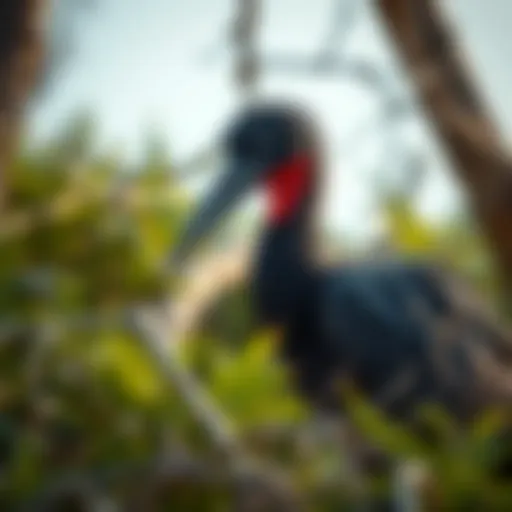Exploring the Parrot Beak: Anatomy, Function, and Health


Intro
The parrot beak, a strikingly unique structure, plays more than just a decorative role in the lives of these vibrant birds. Understanding its intricate anatomy, multifunctional uses, and its utmost importance in daily activity is crucial for bird enthusiasts and caregivers alike. This exploration encompasses not only the physical characteristics of the parrot beak but also dives into the evolutionary adaptations of different species.
Through this discussion, reasons behind specific beak shapes, their implications on feeding behavior, and essential tips for maintaining robust beak health will be laid bare. Furthermore, the behaviors related to beak development that can impact overall well-being will be considered.
Having a deep insight into parrot beaks enriches the connectivity we share with these divine birds, ensuring comeptent care and appreciation for their needs.
Avian Care Basics
To truly respect and nurture pet parrots, proper care practices must be continually observed and understood. Providing proper nutrition is foundational.
Importance of Proper Nutrition
Parrots require a balanced diet rich in vitamins and minerals to support their beak health. Many feeders rely too much on seeds which could lack essential nutrients. A diet consisting of fresh fruits, vegetables, and specially formulated pellets is best.
Understanding Bird Species and Their Needs
Every parrot species has unique requirements. For instance, macaws need larger beaks for cracking tough nuts, while budgerigars have different preferences. Adjusting the care routines according to species can make notable differences.
Basics of Birds Habitat Setup
Ensuring a comfortable habitat can significantly influence health. The cage should be spacious enough to encourage movement, with appropriate perches that help to maintain beak shape.
Grooming and Hygiene Tips
Regular care routines such as nail trimming and beak checks help prevent issues. Parrots also require clean environments, so regular cleaning will maintain good hygiene.
Interacting with Your Pet Bird
Building a smart connection with your parrot can enhance life significantly. Many bird owners often seek ways to retain more meaningful interactions.
Building Trust and Connection
Establishing a calm atmosphere can encourage friendly bonding. Savor each first encounter, allowing them time to adjust rather than forcing interactions.
Training Techniques and Tips
Positive reinforcement works wonders. Birds respond effectively when rewarded during training sessions. Select times in their active periods.
Fun Activities for Bird Owners and Their Birds
Enriching routines can significantly improve mental sharpness. Experiment with puzzle toys, shredding paper, or spawning games that collect different cues.
Recognizing Bird Cues and Behaviors
Awareness of your bird's body language can bring insights into their emotional states. Detect subtle changes, such as how they flap wings or how they're vocalizing.
Emotional Well-Being of Birds
Setting aside space for emotional health is just as critical as their physical care.
The Role of Play and Socialization
Setting time aside for play either with their Human or toys helps alleviate boredom or stress. Societal beings by nature, parrots necessitate interaction vastly to thrive.
Enhancing Birds' Emotional Health
Engage with varied stimulation. Waiting a ritual incorporating verbal affection, playtime around napping can uplift their spirits ultimately.
Assessing Bird Stress and Remedies
Stress in birds often presents through aggressive or frightened behavior. Quiet spaces away from loudness aid the tranquil vibe.
Building Strong Human-Bird Bonds
Consistent interaction and responsiveness build robust relationships with your avian companions. Infusing moments with caring and affection is vital.
Bird Health and Safety
Maintaining vigilance about your bird’s health protects their welfare and ensures a happier existence.
Common Health Issues and Prevention
Manybirds suffer with commonplace conditions music along poor beak health. Healthy dietary measures should counteract potential issues like abnormal growth.
Routine Veterinary Care
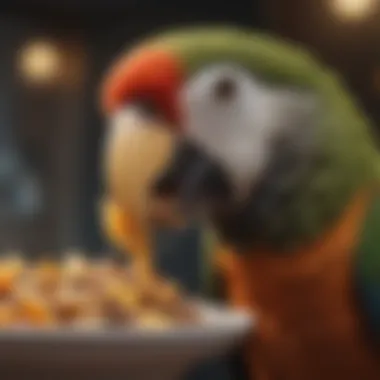

Consulting an avian specialist for routine prend inevitable checks will keep your pet in the lap of health. Schedule routine visits.
Environmental Hazards to Avoid
Keeping a hawk eye on everyday items that can be hazardous, like sexual air fresheners) preserving safety in any chosen habitat.
Signs of Illness or Distress
Pudgy drops in activity or Indigo energy levels often hint at underlying health mysteries needing isolates evaluation.
Fun Facts and Quirky Insights
Further exploration reveals a mosaic of fascinating elements surrounding parrots.
Unique Traits of Popular Bird Species
Constituents behind these creatures overall emerge from lively trajectories of reality where capability abounds, including specific coloration and enthusiasm.
Historical and Cultural Significance of Birds
From ancient traditions to contemporary symbolism, parrots have long drawn the attention of societies. They serve functions ranging from companionship to totems signifying virility.
Famous Bird Owners and Their Stories
Story of renowned owners rings months pioneering potential in forging human-bird friendships that date wides medlemska of lively historic significance.
Knowledge surrounding parrot beaks and overall avian care is essential for maintaining a thriving and fulfilling relationship with your pet. Understanding their needs, body language, and health promotes better interactions.
Intro to the Parrot Beak
The parrot beak is an essential aspect of a parrot's anatomy that highlights the bird's adaptability and diverse functionalities. It plays a crucial role not only in feeding but also in social interactions, environmental adaptations, and overall health. Understanding the parrot beak is vital for pet bird owners, breeders, and enthusiasts alike. This section will explore its significance and set the foundation for deeper insights into parrot physiology.
Addressing the importance of the parrot beak also touches on threats to its health, which may impact behavioral traits and well-being among these vibrant creatures. Hence, uncovering its structure and functions contextualizes why it is of interest to understand in detail.
Understanding Parrot Definitions
Before diving into the anatomy and functions that encompass the parrot beak, it's essential to define certain terms related to our topic.
- Beak (or Bill): This term refers to the hard, pointed structure that signifies a parrot’s mouth, essential for its feeding and grooming behavior.
- Keratin: A fibrous protein making up the beak, providing durability and structural integrity.
- Mandibles: The two sections of the beak—upper and lower—that can occlude, enabling parrots to effectively shred food and manipulate objects.
Understanding these basic concepts offers a clearer picture for the reader and builds an insightful framework for the subsequent sections of this article.
Anatomy of the Parrot Beak
Understanding the anatomy of the parrot beak is important for grasping how these birds interact with their environment. The structure of a parrot’s beak, including its shape and composition, directly affects its feeding abilities and behavior. A comprehensive examinatoin of beak anatomy can informed bird owners about health monitoring and dietary needs.
Major Components of the Beak
The parrot beak consists of several key components, each contributing to its function and health. The upper and lower mandibles are the two main parts of the beak. These components allow for a strong grasp, critical for feeding.
1.
Upper Mandible
- This part typically is larger and more robust, aiding in breaking down food.
- The shape and curvature vary among species, adapted to optimize eating specific foods.
2.
Lower Mandible
- Generally more flexible allowing manipulation of objects and seeds.
- Its mobility enhances the efficiency during the feeding process.
3.
Cere
- Positioned at the base of the beak, the cere holds the nostrils, allowing for better respiratory function.
- Changes in coloration can indicate certain health conditions.
Together, these components are specially designed to assist parrots in grasping, peeling, cracking, and consuming a variety of food items.
The Role of Keratin
Keratin is a resilient protein forming the outer layer of a parrot's beak. Understanding its role is vital for comprehending beak maintenance and growth.
1.
Beak Growth
- The keratin that forms the beak continuously grows, similar to human nails.
- Regular wear from natural activities keeps it at an appropriate length, preventing overgrowth.
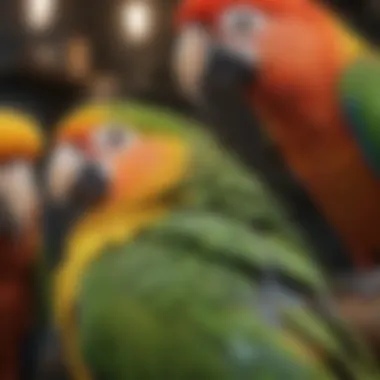

2.
Strength and Protection
- The keratin structure make the beak strong, allowing parrots to handle tough seeds, nuts, and worn surfaces in nature.
- A healthy keratin layer markets a strong and well-functioning beak, influencing overall health.
Functions of the Parrot Beak
The functions of the parrot beak are essential to understanding the overall anatomy and health of these birds. The beak not only serves a practical purpose but also contributes to the social dynamics and adaptation of parrots in their environment. The multifaceted roles that these structures play should not be overlooked in their significance.
Feeding Mechanisms
Parrots have powerful beaks that enable them to consume a wide variety of food. A parrot’s beak is designed for not just cracking nuts but also for peeling fruits and tearing through plant fibers. The strength and shape of the beak are critical for feeding efficiently. For instance:
- Seed Cracking: Parrots often feed on hard seeds which they crack open using the curved beak shape that supports optimal leverage.
- Frugivory: In some species, parrots focus more on fruits and juicy vegetables, and their sleek upper mandible allows for better maneuvering when extracting pulp.
- Foraging Behavior: The versatility found in their beak structure allows parrots to forage for various food sources in their natural habitat, ensuring a balanced diet rich in nutrients.
Social Interaction
The beak is also a vital tool for communication and interaction among parrots. Different beak movements can convey emotional states or social signals, playing a crucial role in their social life. Parrots use their beaks in ways such as:
- Displaying Affection: Gentle nibbles or preening with their beaks are common behaviors that strengthen social bonds within flocks.
- Establishing Dominance: Beaks can be used to establish hierarchy. A dominant parrot may display its beak by assuming aggressive positions or behaviors.
- Sound Production: While parrots are known for vocalization, their beaks assist in producing various sounds. The shape and opening of a beak can enhance or modulate sounds, adding to their complex communication methods.
Environmental Adaptations
Adaptation to their environment is a deeply rooted feature of parrot evolution, heavily influenced by the specific functions of their beaks. Several ecological factors drive this process:
- Habitat Specification: Parrots that live in dense forests may develop broader beaks adapted to handling specific types of food available in their locality.
- Diet Diversification: Some parrots have evolved specialized beak shapes corresponding to niche diets. Those in arid ecosystems might have evolved narrower beaks to allow them to access water contained in certain plants.
- Defensive Mechanisms: Parrots might use their beaks as a threat display. In hostile encounters, showcasing a strong and large beak can deter potential threats, which ensures safety and survival.
In summary, the functions of the parrot beak go beyond mere feeding. Understanding these elements can significantly inform avian enthusiasts about how to care for and support their feathered friends now that this integral part of their anatomy is revealed.
"The beak of a parrot is the most essential tool in their daily survival, both in feeding and in social interactions."
A deeper grasp of these beak functions allows pet bird owners and breeders to cater to their parrots' miner dietary and environmental needs positively.
Evolutionary Aspects of Beak Variation
Understanding the evolutionary aspects of beak variation in parrots helps to uncover significant patterns in their adaptation and survival. The changes in beak shapes, sizes, and functions among different parrot species are a result of long-term evolutionary processes. These variations have proven essential for the parrot's ability to occupy diverse habitats and exploit varied food sources. Moreover, studying this aspect reveals insights into the ecological dynamics and interactions within their environments. Each beak adaptation contributes to the greater context of avian evolution and underscores the mechanics of natural selection.
Adaptive Radiation in Parrots
Adaptive radiation is a concept that refers to the rapid diversification of a single ancestral species into a range of forms to adapt to different environments. In the case of parrots, this phenomenon is particularly observable. Birds within the parrot family have evolved distinct beak shapes and sizes depending on their ecological niches. For instance, parrots which primarily feed on seeds possess stronger, more robust beaks to crack hard shells, whereas nectarivorous species typically exhibit longer, thinner beaks designed for extracting nectar from flowers.
This diverse range of beaks demonstrates how selection pressures can shape a species over time. Adaptive radiation contributes not only to the survival of the species but also to resilience against changes in their environment, particularly in the face of habitat loss and food scarcity.
Additionally, this adaptation process can serve as an indirect evidence of historical climate changes, environmental availability, and the dispersal patterns of birds in varying geographical regions.
Influencing Factors for Beak Evolution
Various factors play a pivotal role in beak evolution among parrots. Environmental changes triggered certain evolutionary paths, forcing species to develop beak characteristics suited for specific dietary needs. The fundamental factors influencing beak evolution include:
- Dietary Habits: The availability and type of food sources are crucial. Species with access to distinct food types, such as fruits, seeds, or flowers, adapt accordingly.
- Habitat Diversity: Different regions with varying climates and ecosystems demand additional adaptations in beak shape and function.
- Competition: As parrots compete for resources, beak variation allows them to minimize direct competition for similar food sources. This leads to niche differentiation, with each species occupying a unique role in their habitat.
- Predation: Beak adaptations can result from the need for better survival strategies. Those species that are more adept at accessing food sources while evading predation tend to survive and reproduce successfully.
The Importance of Beak Health
The beak of a parrot is not just an appendage; it plays a pivotal role in the overall health of the bird. A healthy beak ensures a wide range of capabilities, including proper feeding, communication, and social interactions. Understanding the importance of beak health can significantly influence the quality of life for pet birds and help prevent potential complications. Proper care leads to happier, healthier pets who can thrive in their environment.
Common Beak Issues
Parrots can face numerous beak issues that can affect their well-being. These common problems often stem from dietary deficiencies or inadequate environmental stimulation. Here are several prevalent concerns:
- Overgrowth: A parrot's beak can grow too long without appropriate wear and tear. Heavy beaks may hinder effective feeding and can lead to injury.
- Discoloration: Changes in color may indicate a variety of health issues or may simply signal inadequate diet or dehydration.
- Cracks and Fractures: Beak fractures can arise from accidents. However, they may also indicate underlying health problems that need immediate attention.
- Infections: Bacterial and fungal infections can affect the beak's integrity. Signs may include swelling, redness, or abnormal discharge.
Awareness of these issues forms the first step toward proactive care and intervention. Regular grooming, sufficient dietary intake, and environmental enrichment contribute to preventing these problems.
Signs of Beak Health Problems
Recognizing symptoms of beak-related health issues is crucial for timely intervention. Here are some signs that should prompt consultation with an avian veterinarian:
- Change in Eating Habits: If a parrot shows reluctance or difficulty in eating, it may be a symptom of beak distress.
- Behavioral Changes: Increased aggression or withdrawal may point to discomfort or pain related to beak health.
- Excessive Dropping or Neglect: Birds with beak issues may exhibit unusual lethargy or neglect grooming.
- Visible Deformities or Changes: Any unusual shape, or consistency in the beak warrants careful examination.
Regular beak assessments can prevent long-term damage and ensure health and happiness in birds.
Nutrition's Role in Beak Development
Proper nutrition is vital for the healthy development of a parrot's beak. The beak plays many important functions, including feeding, grooming, and social interaction. Nutrition is the cornerstone of these functions, impacting growth, resilience, and overall health. A balanced diet allows for the proper development of beak structure and strength, essential for long-term beak health. This section discusses specific vitamins and minerals that contribute significantly to beak development.
Essential Vitamins and Minerals
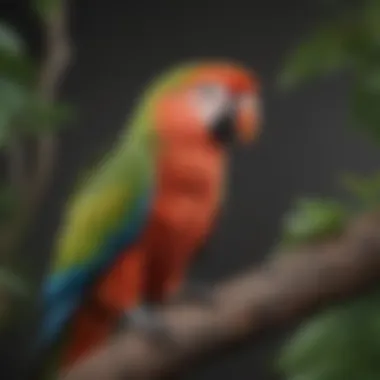

Various vitamins and minerals play a crucial role in maintaining the health of a parrot's beak. Here are some essentials:
- Vitamin A: Vital for maintaining epithelial health, which is crucial in the development of the beak.
- Calcium: Important for bone strength, the beak is also supported by strong jawbones.
- Vitamin D3: Aids in calcium absorption. Without this vitamin, beak integrity suffers.
- B Vitamins: Play a role in cellular metabolism, which helps support the structural components of the beak.
Notably, insufficient intake of these nutrients can lead to deformities and other health complications.
Dietary Sources for Optimal Beak Health
Choosing the right food can greatly enhance your parrot's beak health. Consider the following options for optimal nutrition:
- Fresh Fruits and Vegetables: Sources of Vitamin A and myriad other nutrients. Dark leafy greens are particularly high in essential vitamins.
- Seeds and Nuts: Provide fats, protein, and minerals necessary for a healthy beak.
- Pelleted Diets: These often contain balanced ratios of vitamins and minerals tailored for avian species, supporting overall health including beak wellbeing.
- Supplemental Products: Some products are specifically designed to fortify beak health, available at vet clinics or pet stores.
Incorporating a well-rounded diet filled with these sources helps ensure that your parrot’s beak develops correctly and remains healthy throughout their life.
Behavioral Impacts on Beak Health
Behavioral aspects significantly affect the well-being of parrots, focusing on their beak health. As active and intelligent creatures, parrots rely on their beaks not only for feeding but also for interacting with their environment. A well-maintained beak enables them to explore their surroundings and fulfill their natural instincts. In this section, we will discuss two main facets: the role of natural chewing and foraging behaviors and the impact of boredom and stress on beak health.
Natural Chewing and Foraging Behaviors
Natural chewing and foraging are fundamental to a parrot's daily habits. In the wild, parrots utilize their beaks to break open seeds, manipulate bark, and forage for different edible materials. This behavior not only provides essential nutrition but also exercises their beaks. It prevents overgrowth and related issues such as malocclusion.
When kept as pets, parrots still require stimulation to engage in natural foraging. It is vital to create an environment that mimics an outdoor setup. Bird owners can offer toys made of wood or other materials suitable for chewing.
- Regular Interaction: Encourage your parrot to forage by hiding treats within its habitat.
- Varied Materials: Use a mix of textures and shapes in toys to maximize engagement.
- Observation: Regularly observe how your parrot interacts with these items; this can indicate levels of engagement and beak activity.
In essence, fostering natural chewing can prevent beak-related health issues. A stimulated parrot is less likely to suffer from behavioral problems linked to boredom, which we will examine next.
Impact of Boredom and Stress
Boredom and stress are significant factors affecting the health of a parrot's beak. When a parrot is kept in an unstimulating environment, it might redirect its frustration through destructive behaviors. This can manifest as excessive chewing or even self-harm.
Stress can also manifest physically. If a parrot feels threatened or cornered, it may exhibit unnatural behaviors. These behaviors include not using the beak properly, resulting in shape distortions or overgrowth.
To prioritize your parrot's mental health:
- Environment Enrichment: Introduce accidental enrichments, such as perches of varying sizes and routes, or visually stimulating elements.
- Training and Social Interaction: Engage with your parrot through simple commands or tricks, keeping their mind occupied.
- Cage Size: Ensure the living space is ample for free movement and exploration, reducing stress levels in multiple parrots.
“A mentally stimulated parrot shows higher levels of well-being, directly impacting its physical health, especially beak maintenance.”
Addressing boredom and providing coping strategies can ensure that their beak remains an efficient tool. Ultimately, understanding how behavior influences beak health fosters better care for your feathered companions.
Practical Care Tips for Beak Maintenance
Caring for a parrot’s beak is crucial for its overall well-being. A well-maintained beak promotes better feeding habits and general health. Regular care can prevent many issues that might arise from poor maintenance. The interaction between a parrot’s beak and its daily activities reinforces the necessity for practical care tips.
Regular Beak Checks
Making regular beak checks a part of your routine is fundamental in maintaining your parrot’s health. These checks should be systematic and done often. You want to keep an eye out for signs of growth issues, such as uneven surfaces or excessive length.
A healthy beak should appear smooth and symmetrical. If you notice cracks, discoloration, or abnormal wear, you need to act. Observing your parrot while it eats can also provide insight into its beak's current condition. Preventative examinations can catch early signs of trouble.
Some signs that require immediate attention include:
- Brittle or splitting beak
- Discolored growths or pounds
- Difficulty in eating or any feeding morale change
- Signs of discomfort while foraging
Pet owners can utilize simple tools, like handheld mirrors, to help inspect those hard-to-see areas of the beak closely. If anything unusual appears during checks, consult a veterinarian who specializes in avian care.
Beak Trimming and Care
Beak trimming is an essential component of beak maintenance. Overgrown beaks can lead to complications in feeding and self-grooming. It is important to note that not all parrots will need constant trimming. Some will naturally wear their beaks down through normal activities like chewing and foraging.
If a trim is necessary, it can either be performed at home or by an avian vet, depending on your comfort level. DIY trimming should be approached with caution. Here are the steps to carry out a safe trim:
- Gather necessary tools such as a small nail clipper or a Dremel tool.
- Carefully restrain your parrot, allowing gentle handling.
- Trim a small amount only; excessive trimming may lead to bleeding or sensitivity.
- Make sure to smooth over any rough edges post-trim to prevent injury.
If trimming feels daunting, hiring a professional is often the best route to ensure safe care.
Epilogue
The significance of understanding parrot beaks cannot be understated in the context of avian care practices. This article has worked to illuminate various dimensions, from anatomy to maintenance tips. With a clear comprehension of a parrot's beak, pet bird owners, aspiring bird parents, and breeders can better cater to their feathered companions' needs.
First, recognizing the unique anatomy of parrot beaks aids in identifying health concerns that may arise. Knowledge about beak components and functions enables proactive care, ensuring birds can feed and socialize effectively.
Second, insights into the evolutionary aspects of beak variation highlight how adaptation can affect dietary habits and behavioral traits. Understanding these variations enriches a bird owner's perspective on their pet’s natural inclinations and habitat needs.
Lastly, practical care tips outlined in this article assist owners in maintaining their pets’ beaks. Emphasizing regular checks, appropriate dietary sources, and addressing common health problems play crucial roles in the overall well-being of parrots.
Through this comprehensive understanding of parrot beaks, owners can cultivate healthier environments that cater to their pets’ physical and psychological needs.
Key Takeaways About Parrot Beaks
- Anatomy Matters: Familiarity with the major components of a parrot’s beak promotes better health monitoring.
- Role of Diet: Essential vitamins and minerals derived from appropriate sources significantly impact beak growth and health.
- Behavioral Onus: Natural chewing and foraging behaviors support optimal beak maintenance, emphasizing the importance of environmental stimulation.
- Health Awareness: Knowing signs of beak health issues allows prompt interventions, safeguarding animal well-being.
In summary, the incorporation and application of the information provided regarding parrot beaks serve not only to enhance the life quality of pet birds but also enriches the lifelong relationship between the bird and its owner. Staying informed shall always lead to better practices in avian care.












